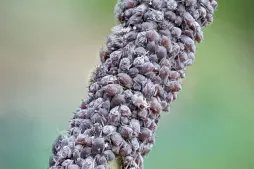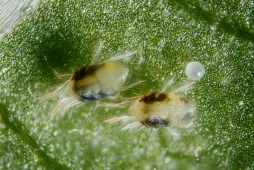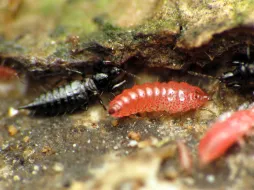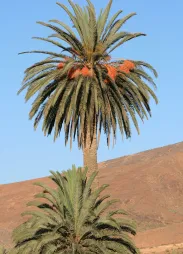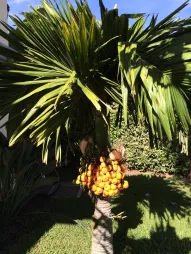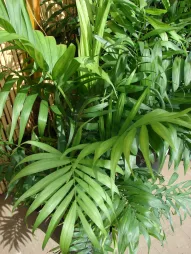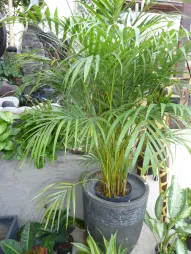Phoenix dactylifera, the date palm of the oases
While the origins of Phoenix canariensis are beyond doubt, those of Phoenix dactylifera remain a mystery. One thing is certain: this member of the Arecaceae family, also known as the date palm, has been cultivated in Africa and Asia since ancient times. Its evergreen foliage announced the presence of an oasis to thirsty travelers.
How to recognize the Phoenix dactylifera date palm?
Phoenix dactylifera is an arching palm that can reach 30 meters in height. In its early years, it grows slowly. It then looks more like a thorny bush than a palm tree.
The false trunk is up to 50 centimetres in diameter. It is covered by the old petioles. While most palms, such as triangle Palm, have a solitary stipe, the Phoenix dactylifera stipe branches.
At the top of the date palm is the crown of palms. It consists of 30 to 50 leaves, four to seven meters long. The linear, glaucous-green leaflets grow on four levels. The lower levels are covered with thorns.
Beige flowers bloom in April. The inflorescence does not exceed 30 centimetres in males. Females grow to over a metre.
They alone produce the date bunches. The brown berries with their sweet flesh contain the yellow seed, which gives rise to a new date tree.
Phoenix dactylifera is non-toxic. It is planted for its fruit or as an ornamental tree. In desert regions, it is also used to shade other crops.
Our maintenance tips
Date palms are easy to grow. To avoid killing them, you need to remember two things:
1. Palms need light. Be careful, however, not to expose it to full southern exposure: too much sun will burn its foliage.
2. Indoor palms like humidity, but hate excess water. Over-watering can rot the roots.
Watering
Allow the substrate to dry on the surface (at least three centimetres) between waterings. Water the root ball of your Phoenix dactylifera with non-calcareous water at room temperature.
Don't forget to empty any stagnant water from the dish or pot. It will rot the roots.
Spray
Date palms appreciate a high degree of humidity. Fogging their foliage increases humidity and prevents the appearance of pests.
Spray with room-temperature water. Use non-calcareous water, such as rainwater, to avoid staining the leaves.
Repotting
In spring, transfer your Phoenix dactylifera to a larger pot, so that it can continue to grow.
Date palmlike all palms, likes to be cramped. Re-pot only if the roots protrude from the drain hole, if they grow on the surface or if the root system rotates in the pot.
The day before repotting, water the root ball and soak the clay pot. This way, it won't absorb all the water during the first watering.
In a pierced terracotta or clay pot, pour a drainage layer (gravel, clay balls) followed by the substrate. You can choose a potting soil for green plants or for citrus and Mediterranean plants.
Fertilization
You can stimulate the development of your plant during its growth phase, in spring and summer, with fertilizer.
To stimulate the growth of your Date palm, use a green plant fertilizer.
Cleaning
The dust that accumulates on the leaves prevents photosynthesis. To ensure that your Date palm takes full advantage of the light, clean its foliage with a clean, damp cloth. Then wipe with a soft cloth.
Prune
Use a clean, sharp tool, such as pruning shears, to cut dry palms flush.
Plantation
Once the last spring frosts have passed, you can plant.
Soak the root ball of your palm tree to rehydrate it.
Select a bright location, but away from direct sunlight. Dig a hole 80 centimetres deep and three times as wide as the root ball. Place clay balls or other material at the bottom to promote drainage. Add a mixture of garden soil, potting soil and sand.
Plant your specimen in the center. Fill in with your substrate until the collar is buried. Water for the first time after planting.
Seedling
Soak seeds in hot water for 48 to 72 hours. Don't hesitate to change the water if it becomes cloudy.
Prepare a one-liter pot for each seed, filled with special potting soil and perlite. Plant the seed two centimetres deep, without burying it completely. Cover and place the pots in a room with a temperature above 20 degrees.
Keep the substrate moist until the seeds begin to germinate.
Diseases / Threats
Information
| Family | Arecaceae - Arecaceae |
| Type | Phoenix - Phoenix |
| Species | Date palm - Phoenix dactylifera |
| Lifecycle | Perennial |
| Foliage | Evergreen |
| Exposures | |
| Substrats | |
| Planting methods |
Open ground In pots In tubs |
| Categories | |
| Tags |
Edible fruit Large pot |
| Origins |
South Africa North Africa West Africa Central Africa Central Asia |
| Hardiness (USDA) | 8b |
| Leaf color |
|
| Flower color |
|
| Fruit color |
|
Discover plants from the same family














